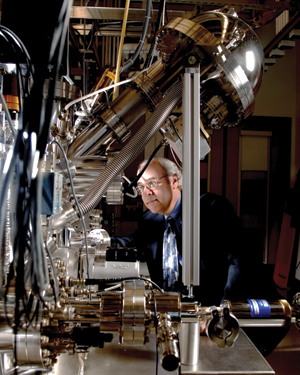Chemistry energized
By Lydialyle Gibson
Photography by Dan Dry

At a new chemistry research center on campus, scientists will use supersonic beams to grow nanocrystals into diamonds for electronic and biomedical instruments. They’ll study electron-driven reactions at the surface of liquids and figure out how to transform carbon dioxide into some other, more beneficial, chemical: formic acid, perhaps, or methanol. They will explore the mechanics of chemical reactions infused with more energy than normal, accelerated by catalytic substances or changes in temperature. In short, says Chicago chemist Steven Sibener (right), the center’s director and principal investigator, the goal is “to find new chemistries or more efficient ways of doing known processes.”
Established in January and supported by a $1.5 million grant from the National Science Foundation, the Center for Energetic Non-Equilibrium Chemistry at Interfaces (CENECI) is a partnership among five research universities: Chicago, MIT, Northwestern, Montana State University, and the University of Wisconsin–Madison. Managed from Sibener’s Gordon Center office, it has labs at each institution, where professors and postdocs from different schools come together to work on long-term, fundamental chemical problems. Chicago’s CENECI is one of several that are part of the NSF’s Centers for Chemical Innovation program, aimed at yielding transformative discoveries in basic chemistry.
